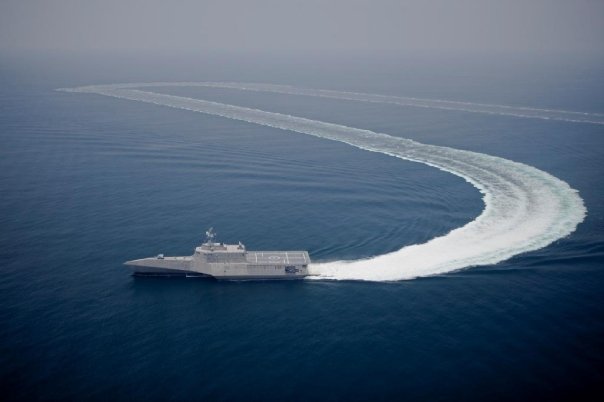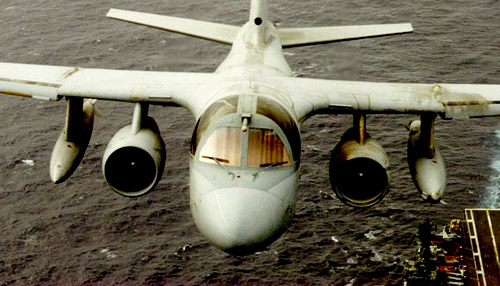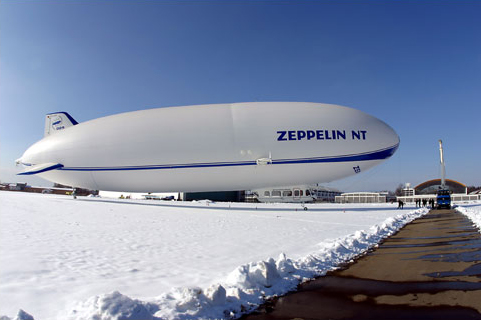July 14, 2009
A Fashionably Late Debutante
Although there have been cost overruns and delays, the second of the competing designs for the Litorral Combat Ship has started sea trials.
Over at Information Dissemination, Galrhan provides the world with the first pics of the sea trials of LCS-2, which will be named USS Independence.


Good grief that thing is maneuverable!
One of the reasons this ship has hit so many time and budget snags may be that it was designed by Aussies, who are the world leaders in the trimaran hull form it uses and aluminum-smithing. I have heard that there was a very steep learning curve for the US Yard in these areas. This is a riskier design and it pushes US shipbuilding to the limit, but I strongly suspect this design will be more stable at all speeds and most sea-states than the Locheed Martin designed LCS1. It ought to have more room for growth and be more fuel efficient too, all other things being equal (which they may well not be).
As always there is a highly informed and interesting discussion in the comments of this post over at Information Dissemination. If this sort of thing interests you, then you should be stopping by there every day.
UPDATE: Gahlran has a bunch of gorgeous high res pictures of the trials.
Over at Information Dissemination, Galrhan provides the world with the first pics of the sea trials of LCS-2, which will be named USS Independence.


It appears that Austal and General Dynamics have successfully weaponized 'bad ass'
Good grief that thing is maneuverable!
One of the reasons this ship has hit so many time and budget snags may be that it was designed by Aussies, who are the world leaders in the trimaran hull form it uses and aluminum-smithing. I have heard that there was a very steep learning curve for the US Yard in these areas. This is a riskier design and it pushes US shipbuilding to the limit, but I strongly suspect this design will be more stable at all speeds and most sea-states than the Locheed Martin designed LCS1. It ought to have more room for growth and be more fuel efficient too, all other things being equal (which they may well not be).
As always there is a highly informed and interesting discussion in the comments of this post over at Information Dissemination. If this sort of thing interests you, then you should be stopping by there every day.
UPDATE: Gahlran has a bunch of gorgeous high res pictures of the trials.
Posted by: The Brickmuppet at
09:12 PM
| Comments (2)
| Add Comment
Post contains 232 words, total size 2 kb.
July 13, 2009
The Natural Preadator of the Submarine
January 29 2009 was a dark day for the US Navy.
On that date the last active squadron of S-3 Vikings, once one of the USN's primary antisubmarine aircraft was retired. It does not currently have a replacement, which is a cause for some concern. This happens as the main surface ASW platform, the Oliver Hazard Perry class frigates are nearing the end of their useful lives. As the last of those go, the helicopters that operated off their decks go away. The Destroyers with helicopter assets are not very numerous and in any event as they are effectively combination battleships and anti air pickets..... and ABM platforms....are likely to be stretched thin with their other duties. This unhappy state of affairs coincides with an explosion of the number and effectiveness of diesel boats in the worlds submarine forces.
Worse still, is the fact that the USN is saddled with a broken procurement system. Ships and even planes can now take years if not DECADES to reach operational capacity. This will take years to fix. Thus any replacement aircraft that are to be acquired quickly and cheaply must be more or less off the shelf, preferably Commercial off the shelf...unfortunately there just is no carrier capable aircraft sitting on a shelf right now.
Topping off this perfect storm of grief is the current financial crisis which is only going to get worse in the near term and the horrific debt the US has incured in the last few months that threatens to bankrupt us...thus any replacement MUST be relatively cheap.
It would be unwise to postpone such a program.
The Second World War experiences of the US and Britain in the Atlantic and Japan in the Pacific demonstrated the price a nation can face when antisubmarine warfare is put on the back burner. Japan did not survive. Its ASW was an afterthought and the island nation was cut off from supplies of both food and industrial materials. Its navy instead put a huge ammount of their maritime industrial bandwidth into building comparitively small numbers of huge, expensive ships that were designed to be qualitatively superior to their foes....and which now litter the Pacific seafloor.
The US and the UK did beat the submarine menace in no small part because at the UK's urging the United States built over 100 escort carriers thanks to its massive industrial capacity...a capacity that has deteriorated. Now to a large extent such capacity exists only in....China.
That is, therefore, a lesson that is non-applicable in the short term.
There was one other interesting and generally unsung weapon that was unique to the USN in WW2. It may fit the requirements of cheap, off the shelf and effective airborne antisubmarine assets.
Dirigibles like the K class airship were astonishingly effective.

more...
On that date the last active squadron of S-3 Vikings, once one of the USN's primary antisubmarine aircraft was retired. It does not currently have a replacement, which is a cause for some concern. This happens as the main surface ASW platform, the Oliver Hazard Perry class frigates are nearing the end of their useful lives. As the last of those go, the helicopters that operated off their decks go away. The Destroyers with helicopter assets are not very numerous and in any event as they are effectively combination battleships and anti air pickets..... and ABM platforms....are likely to be stretched thin with their other duties. This unhappy state of affairs coincides with an explosion of the number and effectiveness of diesel boats in the worlds submarine forces.
Worse still, is the fact that the USN is saddled with a broken procurement system. Ships and even planes can now take years if not DECADES to reach operational capacity. This will take years to fix. Thus any replacement aircraft that are to be acquired quickly and cheaply must be more or less off the shelf, preferably Commercial off the shelf...unfortunately there just is no carrier capable aircraft sitting on a shelf right now.
Topping off this perfect storm of grief is the current financial crisis which is only going to get worse in the near term and the horrific debt the US has incured in the last few months that threatens to bankrupt us...thus any replacement MUST be relatively cheap.
It would be unwise to postpone such a program.
The Second World War experiences of the US and Britain in the Atlantic and Japan in the Pacific demonstrated the price a nation can face when antisubmarine warfare is put on the back burner. Japan did not survive. Its ASW was an afterthought and the island nation was cut off from supplies of both food and industrial materials. Its navy instead put a huge ammount of their maritime industrial bandwidth into building comparitively small numbers of huge, expensive ships that were designed to be qualitatively superior to their foes....and which now litter the Pacific seafloor.
The US and the UK did beat the submarine menace in no small part because at the UK's urging the United States built over 100 escort carriers thanks to its massive industrial capacity...a capacity that has deteriorated. Now to a large extent such capacity exists only in....China.
That is, therefore, a lesson that is non-applicable in the short term.
There was one other interesting and generally unsung weapon that was unique to the USN in WW2. It may fit the requirements of cheap, off the shelf and effective airborne antisubmarine assets.
Dirigibles like the K class airship were astonishingly effective.

USS K-2 gets ready to kick DasBooty
Equipped with sonabuoys, radar, magnetic anomaly detectors, depth charges, and bombs, these little ships became one of the U-Boat commanders worst nightmares. They were actually much smaller than was thought necessary but they still had an endurance of a day and a half at ~60 kts and could hover to boot. There utility can be measured by the fact that not a single merchant vessel escorted by a U-Boat was lost to enemy action during the war.
After the war airships of improved types served as antisubmarine craft, and, increasingly, in the airborne early warning role. In the early 1960's, as part of a larger overall policy of making bad descisions, Robert MacNamera oversaw the dismantling of the Navy airship program. A few years later, it was discovered that hovering and being able to dunk sonars were very useful ASW traits and helicopters were pressed into service as ASW platforms.
Now the lack of any naval blimps today might make one think that there is no way to get this off the shelf. That is not necessarily the case.
The Viking, the plane we want to replace has a payload of about 4,000 pounds of ordinance.

The Zeppelin NT, a rigid airship has a useful payload of about 4100 pounds, so we are in the ballpark. Note though that sensors, like a good radar and a magnetic anomaly detection boom will eat into this, not to mention crew quarters.

The Sentinel 1000 was originally designed with the Navy in mind. It has a payload of 6,000 pounds which allows a bit more leeway in installing sensors.

Endurance of most off the shelf designs would be low, between 12 hours and two days , but they would have far more loiter time than a helicopter or even the Viking they replace. They could replenish at sea vertically like a helicopter to extend their range. Larger airships could be developed incrementally with lessons learned and applied in small construction batches. All of these are smaller than the frontline airships the Navy was operating in the 1950's, so in a few years we could incrementally build up at least to that capability.
Airships are not perfect. Because of their large sail area they have difficulty handling typhoons, or hurricanes and they tend to react badly to nuclear ordinance...

After the war airships of improved types served as antisubmarine craft, and, increasingly, in the airborne early warning role. In the early 1960's, as part of a larger overall policy of making bad descisions, Robert MacNamera oversaw the dismantling of the Navy airship program. A few years later, it was discovered that hovering and being able to dunk sonars were very useful ASW traits and helicopters were pressed into service as ASW platforms.
Now the lack of any naval blimps today might make one think that there is no way to get this off the shelf. That is not necessarily the case.

The Zeppelin NT, a rigid airship has a useful payload of about 4100 pounds, so we are in the ballpark. Note though that sensors, like a good radar and a magnetic anomaly detection boom will eat into this, not to mention crew quarters.


Endurance of most off the shelf designs would be low, between 12 hours and two days , but they would have far more loiter time than a helicopter or even the Viking they replace. They could replenish at sea vertically like a helicopter to extend their range. Larger airships could be developed incrementally with lessons learned and applied in small construction batches. All of these are smaller than the frontline airships the Navy was operating in the 1950's, so in a few years we could incrementally build up at least to that capability.
Airships are not perfect. Because of their large sail area they have difficulty handling typhoons, or hurricanes and they tend to react badly to nuclear ordinance...

Yes, we nuked a blimp...because...well, we just HAD to know.
Click here for supahsize
Click here for supahsize
...but as a quick and dirty solution to ASW aircraft they do seem to have some promise.
This post would not be complete without a brief mention of Aereons, hybrid airships and other developments of the airship concept that promise far greater performance...and have been promising since the early sixties....but have gotten no results. Military Airships is a very comprehensive site dedicated to these craft and Darrell Campbell is quite an ardent and eloquent proponent of their capabilities. His arguments are valid up to a point, namely that the hybrid airship he advocates have vastly greater potential than regular blimps. Specifically these designs combine a lifting body airframe and modern materials to greatly increase performance. However, while the tech is not unsound, it only works on very large ships and, more importantly it is, not mature technology. It will require considerable integration efforts as well as trial and error. These take time and money that we don't have. Rather than letting the best be the enemy of the good, it seems prudent to me to go with what we have and develop the ideal capability through trial and error.
There are many promising technologies that might aid us in hunting submarines, USV swarms, or small craft with dipping sonars using sprint and drift tactics for instance. But the good old blimp is here now, has a proven track record and might be had rather economically. It certainly warrants a look.
This post would not be complete without a brief mention of Aereons, hybrid airships and other developments of the airship concept that promise far greater performance...and have been promising since the early sixties....but have gotten no results. Military Airships is a very comprehensive site dedicated to these craft and Darrell Campbell is quite an ardent and eloquent proponent of their capabilities. His arguments are valid up to a point, namely that the hybrid airship he advocates have vastly greater potential than regular blimps. Specifically these designs combine a lifting body airframe and modern materials to greatly increase performance. However, while the tech is not unsound, it only works on very large ships and, more importantly it is, not mature technology. It will require considerable integration efforts as well as trial and error. These take time and money that we don't have. Rather than letting the best be the enemy of the good, it seems prudent to me to go with what we have and develop the ideal capability through trial and error.
There are many promising technologies that might aid us in hunting submarines, USV swarms, or small craft with dipping sonars using sprint and drift tactics for instance. But the good old blimp is here now, has a proven track record and might be had rather economically. It certainly warrants a look.
Posted by: The Brickmuppet at
03:12 PM
| Comments (3)
| Add Comment
Post contains 1116 words, total size 9 kb.
<< Page 1 of 1 >>
32kb generated in CPU 0.0609, elapsed 0.1396 seconds.
69 queries taking 0.1292 seconds, 185 records returned.
Powered by Minx 1.1.6c-pink.
69 queries taking 0.1292 seconds, 185 records returned.
Powered by Minx 1.1.6c-pink.









